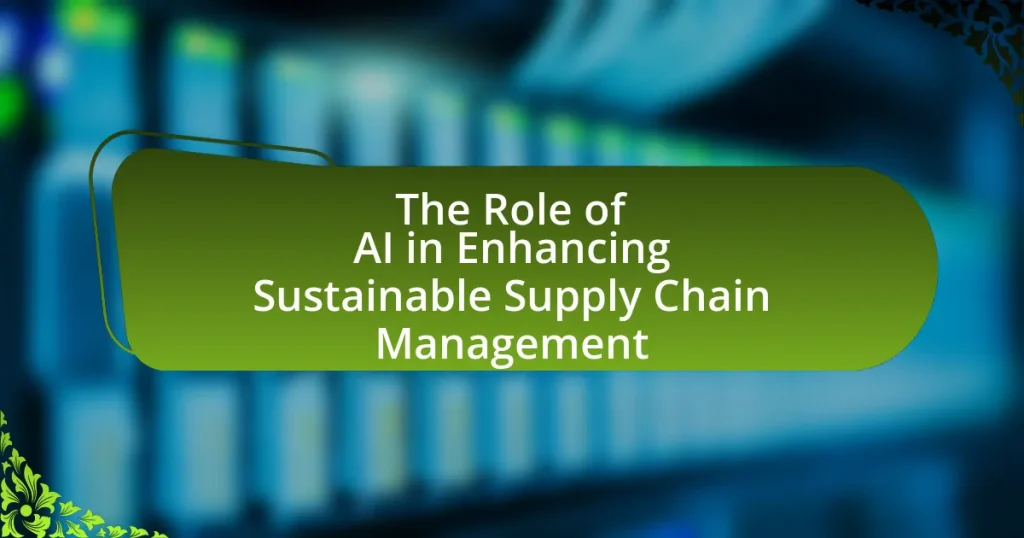Innovative software tools for tracking carbon footprints in supply chains are essential for organizations aiming to enhance sustainability and comply with regulatory demands. Platforms such as EcoVadis, Sphera, and Carbon Trust provide comprehensive solutions for assessing and managing carbon emissions through real-time data integration and advanced technologies like artificial intelligence and blockchain. The article explores how these tools function, their impact on sustainability efforts, the challenges companies face during implementation, and best practices for maximizing their effectiveness. Additionally, it highlights future trends and emerging technologies that could further improve carbon tracking capabilities in supply chains.
![]()
What are Innovative Software Tools for Tracking Carbon Footprints in Supply Chains?
Innovative software tools for tracking carbon footprints in supply chains include platforms like EcoVadis, Sphera, and Carbon Trust. EcoVadis provides a comprehensive sustainability assessment platform that evaluates suppliers based on environmental, social, and governance criteria, enabling companies to identify carbon emissions across their supply chains. Sphera offers a suite of software solutions that focus on environmental performance management, allowing organizations to measure and reduce their carbon footprints effectively. Carbon Trust provides tools and consultancy services that help businesses calculate their carbon emissions and implement strategies for reduction. These tools are essential for companies aiming to enhance sustainability and comply with increasing regulatory demands regarding carbon emissions.
How do these tools function in the context of supply chains?
Innovative software tools for tracking carbon footprints in supply chains function by collecting, analyzing, and reporting data related to greenhouse gas emissions throughout the supply chain process. These tools utilize real-time data integration from various sources, such as transportation, manufacturing, and logistics, to provide a comprehensive view of carbon emissions. For example, tools like Carbon Trust and EcoVadis enable companies to assess their carbon impact by evaluating supplier practices and operational efficiencies, thereby facilitating informed decision-making. The effectiveness of these tools is supported by their ability to generate actionable insights, which can lead to reduced emissions and improved sustainability practices across the supply chain.
What technologies are integrated into these software tools?
Innovative software tools for tracking carbon footprints in supply chains integrate technologies such as artificial intelligence, machine learning, blockchain, and Internet of Things (IoT). These technologies enable real-time data collection, analysis, and verification of carbon emissions across various supply chain stages. For instance, artificial intelligence and machine learning algorithms analyze large datasets to identify emission patterns and optimize processes, while blockchain ensures transparency and traceability of carbon data. IoT devices facilitate the continuous monitoring of emissions by collecting data from equipment and transportation vehicles, providing accurate insights into carbon footprints.
How do these technologies enhance carbon tracking accuracy?
Innovative software tools enhance carbon tracking accuracy by utilizing advanced data analytics, real-time monitoring, and machine learning algorithms. These technologies enable precise measurement of emissions across various supply chain stages by integrating data from multiple sources, such as IoT sensors and enterprise resource planning systems. For instance, a study by the Carbon Trust found that companies using such tools can achieve up to a 30% improvement in emissions reporting accuracy compared to traditional methods. This increased accuracy is crucial for organizations aiming to meet regulatory requirements and sustainability goals effectively.
Why is tracking carbon footprints important for supply chains?
Tracking carbon footprints is important for supply chains because it enables companies to identify and reduce their greenhouse gas emissions, thereby enhancing sustainability. By measuring carbon footprints, organizations can pinpoint high-emission areas within their supply chains, allowing for targeted interventions that improve efficiency and lower costs. For instance, a study by the Carbon Trust found that companies that actively track and manage their carbon emissions can reduce costs by up to 20% through improved resource management and operational efficiencies. This proactive approach not only meets regulatory requirements but also aligns with consumer demand for environmentally responsible practices, ultimately leading to a competitive advantage in the market.
What impact does carbon tracking have on sustainability efforts?
Carbon tracking significantly enhances sustainability efforts by providing organizations with precise data on their greenhouse gas emissions. This data enables companies to identify key areas for improvement, set measurable reduction targets, and implement strategies to minimize their carbon footprint. For instance, a study by the Carbon Trust found that businesses that actively track and manage their carbon emissions can reduce their overall emissions by up to 20% within a few years. By utilizing innovative software tools for tracking carbon footprints, organizations can make informed decisions that align with sustainability goals, ultimately contributing to global efforts to combat climate change.
How does carbon footprint tracking influence regulatory compliance?
Carbon footprint tracking significantly influences regulatory compliance by providing organizations with accurate data on their greenhouse gas emissions, which is essential for meeting legal requirements. Regulatory bodies increasingly mandate emissions reporting, and tracking tools enable companies to monitor, report, and verify their carbon outputs in real-time. For instance, the European Union’s Emissions Trading System requires companies to report their emissions, and effective tracking ensures compliance with these regulations, thereby avoiding penalties. Furthermore, organizations that utilize carbon footprint tracking can identify areas for improvement, align with sustainability goals, and enhance their reputation, which is increasingly tied to regulatory frameworks.
What challenges do companies face when implementing these tools?
Companies face several challenges when implementing innovative software tools for tracking carbon footprints in supply chains. One significant challenge is data integration, as companies often struggle to consolidate data from various sources and systems, leading to inconsistencies and inaccuracies. Additionally, there is a lack of standardized metrics for measuring carbon footprints, which complicates the comparison and analysis of data across different suppliers and regions. Furthermore, employee training and change management are critical hurdles, as staff may resist adopting new technologies or lack the necessary skills to utilize them effectively. According to a report by McKinsey, 70% of digital transformation initiatives fail due to these human factors, underscoring the importance of addressing organizational culture and training when implementing such tools.
What are the common barriers to adoption of carbon tracking software?
Common barriers to the adoption of carbon tracking software include high implementation costs, lack of technical expertise, and insufficient data integration capabilities. High implementation costs deter organizations from investing in these tools, as they may require significant upfront capital and ongoing maintenance expenses. Additionally, many companies lack the technical expertise needed to effectively utilize and manage carbon tracking software, leading to underutilization or ineffective application. Furthermore, insufficient data integration capabilities hinder the seamless incorporation of carbon tracking software with existing systems, making it challenging for organizations to gather and analyze relevant data efficiently. These barriers collectively impede the widespread adoption of carbon tracking software in supply chains.
How can companies overcome these challenges effectively?
Companies can effectively overcome challenges in tracking carbon footprints in supply chains by implementing innovative software tools that provide real-time data analytics and transparency. These tools enable companies to monitor emissions at every stage of the supply chain, facilitating informed decision-making and accountability. For instance, a study by the Carbon Trust found that organizations using advanced tracking software reduced their carbon emissions by an average of 20% within the first year of implementation. By leveraging such technology, companies can identify inefficiencies, optimize logistics, and engage suppliers in sustainability initiatives, ultimately leading to a more sustainable supply chain.

What features should be considered when selecting software tools?
When selecting software tools for tracking carbon footprints in supply chains, key features to consider include data integration capabilities, user-friendly interfaces, real-time analytics, and compliance with environmental regulations. Data integration capabilities ensure that the software can seamlessly connect with existing systems, allowing for accurate data collection from various sources. A user-friendly interface enhances accessibility for all stakeholders, facilitating easier adoption and usage. Real-time analytics provide immediate insights into carbon emissions, enabling timely decision-making and adjustments. Compliance with environmental regulations is crucial, as it ensures that the software adheres to legal standards and supports sustainability goals. These features collectively enhance the effectiveness and reliability of software tools in managing carbon footprints within supply chains.
How do user interface and experience affect tool effectiveness?
User interface and experience significantly impact tool effectiveness by influencing user engagement and task completion rates. A well-designed user interface enhances usability, allowing users to navigate the tool efficiently, which leads to quicker and more accurate data entry and analysis. For instance, research by Nielsen Norman Group indicates that users are 50% more likely to complete tasks when interfaces are intuitive and visually appealing. Furthermore, positive user experience fosters user satisfaction and retention, which are critical for tools aimed at tracking carbon footprints in supply chains, as consistent usage is necessary for accurate data collection and reporting.
What design elements enhance usability for supply chain managers?
User-friendly interfaces, intuitive navigation, and real-time data visualization are design elements that enhance usability for supply chain managers. User-friendly interfaces simplify interactions, allowing managers to quickly access necessary information. Intuitive navigation ensures that users can efficiently move through the software, reducing the time spent searching for features. Real-time data visualization presents complex data in an easily digestible format, enabling managers to make informed decisions swiftly. These elements collectively improve operational efficiency and decision-making capabilities in supply chain management.
How does user feedback shape software improvements?
User feedback shapes software improvements by providing developers with direct insights into user experiences and needs. This feedback allows developers to identify bugs, enhance features, and prioritize updates that align with user expectations. For instance, a study by the Nielsen Norman Group found that user testing can reveal usability issues that developers may overlook, leading to more intuitive software design. Additionally, incorporating user suggestions can increase user satisfaction and retention, as evidenced by a report from UserVoice, which states that 70% of users are more likely to continue using a product that actively incorporates their feedback.
What data integration capabilities are essential for these tools?
Essential data integration capabilities for innovative software tools tracking carbon footprints in supply chains include real-time data synchronization, support for multiple data formats, and robust API connectivity. Real-time data synchronization ensures that carbon emissions data is updated continuously, allowing for accurate tracking and reporting. Support for multiple data formats enables the integration of diverse data sources, such as IoT devices, ERP systems, and third-party databases, facilitating comprehensive analysis. Robust API connectivity allows these tools to seamlessly connect with existing software ecosystems, enhancing interoperability and data flow across platforms. These capabilities are critical for effective monitoring and management of carbon footprints in supply chains.
How do these tools connect with existing supply chain management systems?
Innovative software tools for tracking carbon footprints connect with existing supply chain management systems through application programming interfaces (APIs) that facilitate data exchange. These APIs enable seamless integration, allowing the tools to access real-time data from supply chain systems, such as inventory levels, transportation logistics, and supplier information. For instance, a study by the World Economic Forum highlights that integrating carbon tracking tools with supply chain management systems can enhance visibility and accountability, leading to more sustainable practices. This connection allows organizations to monitor emissions effectively and make informed decisions to reduce their carbon footprint.
What types of data sources are most beneficial for accurate tracking?
The most beneficial data sources for accurate tracking in supply chains include IoT sensors, enterprise resource planning (ERP) systems, and third-party logistics data. IoT sensors provide real-time data on emissions and resource usage, enabling precise monitoring of carbon footprints. ERP systems integrate various business processes and offer comprehensive data on inventory, production, and transportation, which is crucial for calculating emissions accurately. Third-party logistics data enhances visibility into transportation emissions and helps in assessing the overall carbon impact of supply chain activities. These data sources collectively improve tracking accuracy by providing detailed, real-time insights into supply chain operations.

What are the best practices for utilizing these software tools?
The best practices for utilizing innovative software tools for tracking carbon footprints in supply chains include ensuring accurate data input, integrating with existing systems, and regularly updating software for optimal performance. Accurate data input is crucial as it directly affects the reliability of carbon footprint calculations; studies show that data inaccuracies can lead to significant miscalculations in emissions reporting. Integration with existing systems enhances efficiency by streamlining processes and reducing redundancy, which is supported by research indicating that integrated systems can improve data accessibility and decision-making speed. Regular software updates are essential to incorporate the latest features and compliance requirements, as outdated software can lead to vulnerabilities and inefficiencies.
How can companies maximize the benefits of carbon tracking software?
Companies can maximize the benefits of carbon tracking software by integrating it into their overall sustainability strategy and ensuring accurate data collection. By aligning carbon tracking with business objectives, such as reducing emissions and improving operational efficiency, companies can identify key areas for improvement. Accurate data collection is essential, as it enables organizations to monitor their carbon footprint effectively and make informed decisions. For instance, a study by the Carbon Trust found that companies using carbon tracking software can reduce emissions by up to 20% within the first year of implementation. Additionally, regular training for employees on how to use the software can enhance its effectiveness, leading to better data utilization and reporting.
What strategies can enhance data accuracy and reliability?
Implementing data validation techniques enhances data accuracy and reliability. These techniques include automated checks for data entry errors, consistency checks across datasets, and the use of standardized formats for data collection. For instance, a study by the International Journal of Information Management found that organizations employing automated data validation processes reported a 30% reduction in data errors. Additionally, regular audits and cross-referencing data with trusted sources further ensure the integrity of the information collected.
How should companies train staff to use these tools effectively?
Companies should train staff to use innovative software tools for tracking carbon footprints in supply chains through structured, hands-on training programs. These programs should include interactive workshops that focus on real-world applications of the tools, ensuring that employees understand both the functionality and the importance of accurate carbon tracking. Additionally, companies should provide ongoing support and resources, such as user manuals and access to online tutorials, to reinforce learning and address any challenges that arise. Research indicates that organizations that implement comprehensive training programs see a 30% increase in tool adoption rates, leading to more effective carbon management practices.
What are the future trends in carbon tracking software for supply chains?
Future trends in carbon tracking software for supply chains include increased integration of artificial intelligence and machine learning for real-time data analysis, enhanced transparency through blockchain technology, and the development of more user-friendly interfaces for better accessibility. AI and machine learning can optimize carbon footprint calculations by analyzing vast datasets, leading to more accurate emissions tracking. Blockchain technology offers immutable records of carbon data, fostering trust among stakeholders. Additionally, user-friendly interfaces will facilitate broader adoption among companies of varying sizes, making carbon tracking more accessible and actionable. These trends are supported by the growing demand for sustainability in supply chains, as evidenced by a 2022 report from McKinsey, which indicated that 70% of companies are prioritizing sustainability initiatives.
How is artificial intelligence shaping the future of carbon tracking?
Artificial intelligence is revolutionizing carbon tracking by enhancing data collection, analysis, and reporting capabilities. AI algorithms can process vast amounts of environmental data from various sources, such as satellite imagery and IoT sensors, to provide real-time insights into carbon emissions across supply chains. For instance, a study by the World Economic Forum highlights that AI can improve emissions forecasting accuracy by up to 30%, enabling companies to make informed decisions about reducing their carbon footprints. Additionally, AI-driven tools can automate the tracking process, ensuring compliance with regulations and facilitating transparent reporting, which is essential for sustainability initiatives.
What emerging technologies could further improve tracking capabilities?
Emerging technologies that could further improve tracking capabilities include blockchain, Internet of Things (IoT), and artificial intelligence (AI). Blockchain enhances transparency and security in data sharing, allowing for immutable records of transactions and movements within supply chains. IoT devices facilitate real-time data collection and monitoring, enabling precise tracking of goods and their carbon footprints throughout the supply chain. AI algorithms can analyze vast amounts of data to optimize tracking processes, predict trends, and identify inefficiencies. These technologies collectively enhance the accuracy and reliability of tracking capabilities, as evidenced by case studies showing significant reductions in carbon emissions through improved supply chain management.
What practical steps can companies take to implement these tools successfully?
Companies can implement innovative software tools for tracking carbon footprints in supply chains successfully by following a structured approach. First, they should conduct a comprehensive assessment of their current supply chain processes to identify areas where carbon tracking can be integrated. This assessment should include evaluating existing data sources and technology infrastructure.
Next, companies must select appropriate software tools that align with their specific needs and goals, ensuring these tools can capture relevant data accurately. Training employees on how to use these tools effectively is crucial, as it enhances data accuracy and user engagement.
Additionally, establishing clear metrics for measuring carbon emissions and setting reduction targets will provide a framework for evaluating the effectiveness of the implemented tools. Regularly reviewing and updating the software and processes based on feedback and technological advancements will further ensure ongoing success.
Research indicates that companies that actively engage in these steps can reduce their carbon emissions by up to 30% within the first year of implementation, demonstrating the effectiveness of a structured approach to integrating carbon tracking tools.


